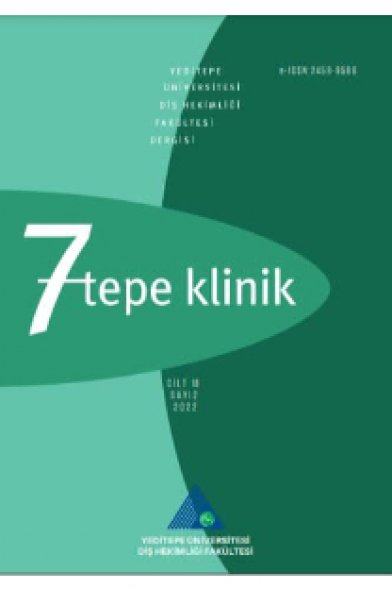Değişen sinterleme sürelerinin dental zirkonyanın optik özellikleri üzerine etkisi
The effect of changing sintering time on the optical properties of dental zirconia
___
- Anusavice KJ. Recent developments in restorative dental ceramics. J Am Dent Assoc 1993; 124: 72-74.
- Hannink RHJ, Kelly PM, Muddle B. Transformation toughening in zirconia-containing ceramics. J Am Ceram Soc 2000; 83: 461-487.
- Fischer J, Stawarczyk B. Compatibility of machined Ce-TZP/Al2O3 nanocomposite and a veneering ceramic. Dent Mater 2007; 23: 1500-1505.
- Aboushelib MN, Feilzer CJ, Feilzer AJ. Evaluation of a high fracture toughness composite ceramic for dental applications. J Prosthodont 2008; 17: 538-544.
- Vult von Steyern PV, Carlson P, Nilner K. All-ceramic fixed partial dentures designed according to the DC Zircon technique: a 2-year clinical study. J Oral Rehabil 2005; 32: 180-187.
- Raigrodski AJ et. al. The efficacy of posterior -unit zirconium-oxidebased ceramic fixed partial dental prostheses: a prospective clinical pilot study. J Prosthet Dent 2006; 96: 237-244.
- Sailer I et. al. Five-year clinical results of zirconia frameworks for posterior fixed partial dentures. Int J Prosthodont 2007; 20: 383-388.
- Edelhoff D, Florian B, Florian W, Johnen C. HIP zirconia fixed partial dentures – clinical results after 3 years of clinical service. Quintessence Int. 2008; 39: 459-471.
- Schmitt J et. al. Zirconia posterior-fixed partial dentures: a prospective clinical-year follow-up. Int J Prosthodont. 2009; 22: 597-603.
- Ilie N, Stawarczyk B. Quantification of the amount of blue light passing through monolithic zirconia with respect to thickness and polymerization conditions. J Prosthet Dent 2015; 113: 114-121.
- Shah K, Holloway JA, Denry IL. Effect of coloring with various metal oxides on the microstructure, color, and flexural strength of 3Y-TZP. J Biomed Mater Res B Appl Biomater 2008; 87 :329-337.
- Zhang Y. Making yttria-stabilized tetragonal zirconia translucent. Dent Mater 2014; 30: 1195-1203.
- Lange FF. Transformation toughening: experimentalobservations in the ZrO2–Y2O3 system. J Mater Sci 1982; 17: 240-246.
- Zhang Y, Griggs JA, Benham AW. Influence of powder/liquid mixing ratio on porosity and translucency of dental porcelains. J Prosthet Dent 2004; 91: 128-135.
- Heffernan MJ et. al. Relative translucency of six all-ceramic systems. Part I: core materials. J Prosthet Dent 2002; 88: 4-9.
- Kelly JR, Nishimura I, Campbell SD. Ceramics in dentistry: historical roots and current perspectives. J Prosthet Dent 1996; 75: 18-32.
- Chen YM, Smales RJ, Yip KH, Sung WJ. Translucency and biaxial flexural strength of four ceramic core materials. Dent Mater 2008; 24: 1506-1511.
- Tsukuma K, Kubota Y, Tsukidate T. Thermal and mechanical properties of Y2O3-stabilized tetragonal zirconia polycrystals. Science and technology of zirconia II. Advances in Ceramics 1984; 12: 382-390.
- Anselmi-Tamburini U, Woolman JN, Munir ZA. Transparent nanometric cubic and tetragonal zirconia obtained by highpressure pulsed electric current sintering. Adv Funct Mater 2007; 17: 3267-3273.
- Kim MJ, Ahn JS, Kim JH, Kim HY, Kim WC. Effects of the sintering conditions of dental zirconia ceramics on the grain size and translucency. J Adv Prosthodont. 2013; 5: 161-166.
- Stawarczyk B, et. al. The effect of zirconia sintering temperature on flexural strength, grain size and contrast ratio. Clin Oral Invest 2013; 17: 269-274.
- Hjerppe J, Narhi T, Froberg K, Vallittu PK, Lassila LV. Effect of shading the zirconia framework on biaxial strength and surface microhardness. Acta Ododntol Scand 2008; 66: 262-267.
- Jiang L, Liao Y, Wan Q, Li W. Effects of sintering temperature and particle size on the translucency of zirconium dioxide dental ceramic. J Mater Sci Mater Med 2011; 22: 2429-2435.
- Piconi C, Maccauro G. Zirconia as a ceramic biomaterial. J Biomater 1999; 20: 1-25.
- Matsui K, Yoshida H, Ikuhara Y. Isothermal sintering effect on phase separation and grain growth in yttria-stabilized tetragonal zirconia polycrystal. J Am Ceram Soc 2009; 92: 467-475.
- Vichi A, Sedda M, Fabian FR, Carrabba M, Comparison of Contrast Ratio, Translucency Parameter, and Flexural Strength of Traditional and "Augmented Translucency" Zirconia for CEREC CAD/CAM System. J Esthet Restor Dent 2016; 28: 32-39.
- Falcone ME, Kelly JR, Rungruanganut P. In Vivo Color Relationships Between the Maxillary Central Incisors and Canines as a Function of Age. Int J Prosthodont 2016; 29: 496-502.
- Ersoy NM, Aydoğdu HM, Değirmenci BÜ, Çökük N, Sevimay M. The effects of sintering temperature and duration on the flexural strength and grain size of zirconia. Acta Biomater Odontol Scand 2015; 1: 43-50.
- Çelenk MF, Hızlı Ve Klasik Sinterleme Uygulanan Zirkonyanın Farklı Yüzey İşlemleri Sonrası Seramik Bağlantısının Ve Mekanik Özelliklerinin Değerlendirilmesi, Diş Hekimliğinde Uzmanlık Tezi, 2016.
- Min-Chieh Liu, Steven Aaquilino, Peter S Lung, . Human Perception of Dental Porcelain Translucency Correlated to Spectrophotometric Measurements. J Prosthodont 2010; 19: 187-193.
- Barizon KT, Bergeron C, Vargas MA, . Ceramic materials for porcelain veneers. Part I: correlation between translucency parameters and contrast ratio. J Prosthet Dent 2013; 110: 397-401.
- Mi-Jin K, Jin-Soo A, Ji-Hwan K, Hae-Young K, Woong-Chul K. Effects of the sintering conditions of dental zirconia ceramics on the grain size and translucency. J Adv Prosthodont 2013; 5: 161-166.
- Kamal Ebeida, et. al. Effect of changes in sintering parameters onmonolithic translucent zirconia. Dental materials 2014; 30: 419-424.
- Hee-Kyung K, Sung-Hun K, Jai-Bong L, Seung-Ryong H. Effects of surface treatments on the translucency, opalescence, and surface texture of dental monolithic zirconia ceramics. J Prosthet Dent 2016; 115: 773-779.
- ISSN: 2458-9586
- Yayın Aralığı: Yılda 3 Sayı
- Başlangıç: 2005
- Yayıncı: Yeditepe Üniversitesi Rektörlüğü
Ekstraoral fistül: Bir olgu sunumu
Endodontide çalışma boyu belirleme yöntemleri
Ortodontik pekiştirme döneminde hasta memnuniyeti ve ağız hijyeninin değerlendirilmesi
R Burcu Nur YILMAZ, Nigora ÇELEN, FULYA ÖZDEMİR
Murat ALKURT, Mustafa GÜNDOĞDU, Zeynep YEŞİL DUYMUŞ, Tugay ŞİŞÇİ, Fikret Özgür COŞKUN, Mustafa YILDIRIM
MURAT ALKURT, ZEYNEP YEŞİL DUYMUŞ, MUSTAFA GÜNDOĞDU
A giant mandibular dentigerous cyst associated with a compound odontoma: A case report
SERCAN KÜÇÜKKURT, HÜSEYİN CAN TÜKEL, EMRE BARIŞ
Assesment of submandibular fossa depth using cone beam computed tomography
M. Oğuz BORAHAN, Fatma Güler DÖNMEZ, Gamze ULAY, Ayşe Nur YILDIZ SADIKOĞLU, Filiz NAMDAR PEKİNER
Periodontal hastalığa sahip bireylerde periodontal tedavinin tat duyusu üzerine etkisi
